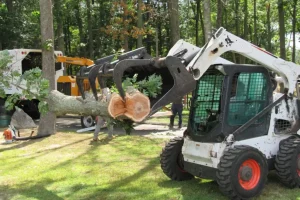Amid urbanization’s challenges, preserving trees is crucial. Trees are vital for ecosystems, hosting diverse species and combating carbon emissions. Understanding threats to trees is key to ensuring their survival. Let’s explore factors contributing to their decline and ways to address these issues for a healthier environment, including a comprehensive guide to tree preservation.
Key Takeaways
- Tree preservation is crucial for maintaining ecological balance, providing habitats for diverse species, and producing oxygen for human life.
• Human activities, natural disturbances, and diseases pose significant threats to tree health, emphasizing the need for proactive preservation measures. - Preserving mature trees is essential for reducing climate change impacts, improving air quality, supporting mental health, and boosting property values.
- Effective tree preservation strategies involve regular pruning, soil care, and pest management to ensure tree longevity and health.
- Proper tree care practices, including regular pruning and pest management, are vital for a healthier environment and improving air quality.
Understanding Tree Preservation Importance
The intricate network of roots, branches, and canopies that comprise a tree’s ecosystem plays a vital role in maintaining ecological balance, underscoring the significance of tree preservation in modern times. A Complete Guide to Tree Preservation is crucial in recognizing the importance of preserving trees, as they provide habitats, absorb carbon dioxide, and produce oxygen, ultimately sustaining life on Earth.
Threats to Tree Health and Longevity
Within a Thorough Guide to Tree Preservation, threats to tree health and longevity cannot be overlooked. As the significance of tree preservation becomes increasingly apparent, it is also essential to acknowledge the numerous threats that compromise tree health and longevity, including human activities, natural disturbances, and diseases. These hazards can cause irreversible damage, emphasizing the need for proactive preservation measures.
Benefits of Preserving Mature Trees
What role do fully grown trees play in maintaining ecosystem balance, and how can conserving them benefit the environment and human societies? Preserving mature trees is essential, as they provide habitats for diverse species, reduce climate change impacts, and improve air quality. They also support mental health, boost property values, and create visually appealing surroundings, ultimately contributing to a Thorough Guide to Tree Preservation.
Effective Tree Preservation Strategies
As mature trees continue to provide ecological balance and societal benefits, implementing effective tree preservation strategies is vital to guarantee their longevity and continued contributions to an Exhaustive Guide to Tree Preservation. Strategies include regular pruning, soil care, and pest management, ensuring trees remain healthy and resilient in the face of environmental stressors.
Tree Care for a Healthier Environment
As part of this In-Depth Guide to Tree Preservation, we delve into the significance of tree care in promoting a healthier environment. Nearly 20% of the world’s oxygen is produced by trees, making tree maintenance a crucial component in maintaining a healthier environment. Proper tree care practices, including regular pruning and pest management, guarantee trees thrive, resulting in improved air quality and a healthier ecosystem.

Frequently Asked Questions
How Do I Identify the Ideal Tree Species for My Local Climate?
To identify the best tree species for your local climate, consult with local nurseries, botanical gardens, or arborists to determine species adapted to your region’s temperature, precipitation, and soil conditions, ensuring ideal tree health and longevity.
Can I Preserve Trees on Private Property Without Government Permission?
Usually, private property owners can maintain trees without government permission, but local regulations and zoning laws may apply; it is crucial to consult with local authorities and arboriculture experts to guarantee compliance.’
Are There Any Tax Benefits for Preserving Trees on Personal Property?
Yes, maintaining trees on personal property can provide tax advantages, such as deductions for tree upkeep and care costs, and possibly decreasing property taxes through conservation agreements or tree protection programs.
How Often Should I Inspect My Trees for Signs of Disease or Pests?
Regular tree inspections are vital for early detection of diseases and pests. Inspect your trees quarterly, or bi-monthly in high-risk areas, focusing on signs of decay, cracks, and unusual growth patterns to guarantee timely interventions and prevent further damage.
Can I Preserve Trees That Are Already Dead or Dying?
While it’s challenging to preserve trees that are already expired or perishing, in some cases, removal of deadwood and pruning can revive stressed trees, but severely damaged trees may require removal to prevent hazards and promote ecosystem health.
Conclusion
In summary, tree preservation is vital for maintaining ecological balance, biodiversity, and environmental health. Effective preservation strategies, including sustainable urban planning, tree care, and conservation efforts, are necessary to address threats to tree health and longevity. By prioritizing tree preservation, ecosystems can be sustained, and the health of future generations guaranteed.
You May Also Like:
